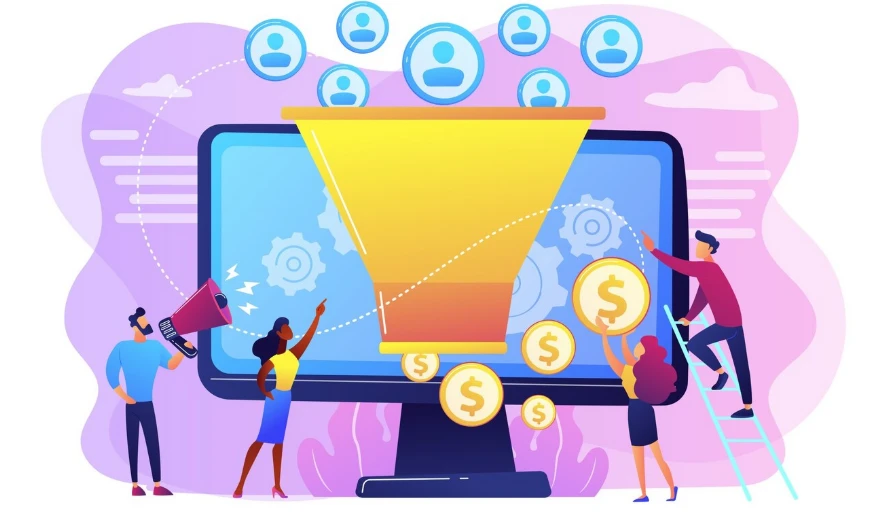What Is a Lead Generation Funnel and How It Works in B2B Marketing
Many businesses struggle with lead quality simply because they don’t fully understand what is a lead generation funnel and how to build one effectively.
In B2B, things take more time. You’re not dealing with impulse buyers but with entire teams, budgets, and approval chains. That’s why a funnel is crucial. It enables you to build trust, educate, and stay relevant throughout a longer, more complex buying journey.

How to Build a High-Performing Funnel in B2B
1. Map Your Funnel to the Buyer’s Journey
Start by understanding how your buyers behave. In B2B, there’s research, comparison, more research, internal discussions, and then maybe someone clicks “Book a demo.”
Your funnel needs to reflect that. Awareness content should answer big-picture questions and speak directly to top of the funnel leads who are just starting to explore their options. Consideration stage? That’s where the middle of funnel content comes in — think case studies, ROI calculators, and competitor comparisons that help buyers evaluate their options. And at the decision stage, it’s all about clear next steps and low-friction calls-to-action.
Don’t just rely on one channel. B2B buyers bounce between email, LinkedIn, your website, and even Slack communities. Be present where they hang out.
2. Personalize at Scale
Nobody’s impressed by “Hi [FirstName]” anymore. If your outreach stops there, you’re already behind.
Modern personalization involves understanding a lead’s role, intent, and pain points, and then tailoring your message accordingly. For instance, a CTO and a Sales Director care about very different things, even if they work at the same company.
Use tools that allow you to segment based on behavior: who visited your pricing page, who clicked your LinkedIn ad, and who downloaded a whitepaper but didn’t follow up. With that insight, you can trigger smart pop-ups, send relevant follow-up emails, or set up effective B2B lead nurturing workflows that keep the conversation going without overwhelming the prospect.
3. Integrate Tech Stack Smartly
Your funnel doesn’t live in one tool. It stretches across your CRM, email platform, landing pages, analytics, and possibly a few spreadsheets if we’re being honest.
The goal is to get these tools talking to each other. Your CRM should reflect who opened your emails. Your pop-up tool should be able to determine if someone is already in your pipeline. Your reps should see what content a lead has engaged with before the first call.
Platforms like CloudShare help you engage leads in real-time with product experiences that show value, not just talk about it. Tools like OptiMonk make your website smarter, delivering the right message to the right visitor at the right time.
When your tech stack works together, your funnel flows smoother, and your team spends less time chasing and more time closing.
Common B2B Funnel Mistakes
Even with a solid strategy, it’s easy to slip into habits that slow your funnel down or send the wrong signals to potential buyers. Here are some of the most common B2B mistakes — and what to do instead.
Treating All Leads the Same
Not every lead is ready for a sales call. Some just want to read a blog post. Others are comparing vendors. If you hit them all with the same message, you’ll lose attention fast.
Fix: Segment your audience based on behavior, role, and funnel stage. Add lead scoring so your sales team knows who’s warm and who’s just window shopping.
Overloading with CTAs Too Soon
Asking for a meeting in your first touchpoint — before the lead even knows what you do — is like asking for a second date before the first one starts.
Fix: Match your call-to-action to the funnel stage. Early-stage leads need info, not pressure. Save demos and consultations for when someone’s shown genuine interest.
No Feedback Loop Between Sales & Marketing
Marketing says the leads are excellent. Sales says the leads are garbage. Nobody wins.
Fix: Create shared KPIs — think Sales Qualified Leads (SQLs), not just Marketing Qualified Leads (MQLs), so both teams are working toward the exact definition of success. Encourage regular check-ins between teams. When everyone is aligned, the whole funnel runs more smoothly.
Conlusion
In B2B, success rarely comes from a single pitch or email. It comes from showing up with the correct value, at the right time, with the right message. A well-structured funnel makes that possible.
It’s not just about filling the pipeline. It’s about creating a repeatable, reliable process that builds trust and delivers results. And that’s how you grow.




